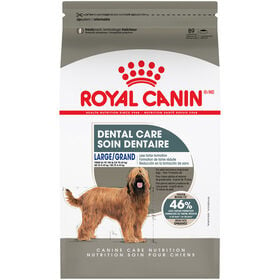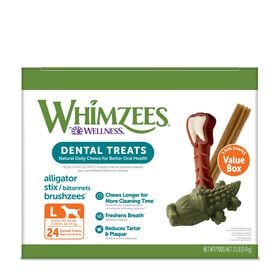Often depicted in family movies or cartoons, the old English sheepdog, also known as the bobtail, is a unique looking dog with a gentle nature that is extremely well suited for families with children.
Physical appearance
Immediately recognizable by the absence of a tail and a long, thick, shaggy grey and white coat, with fur covering its face and eyes, the old English sheepdog is a large, sturdy, symmetrical dog, with a square-proportioned body. Males are generally 56 cm (22 in.) tall and females, 53 cm (21 in.), sometimes a bit taller. Their weight is proportional to their height, generally between 27 kg (60 lbs) and 45 kg (100 lbs). They have an intelligent expression, and their eyes can be brown, blue or one of each, but darker is preferred. The skull is large and squarely formed, and the nose is always black.
The double coat, whose guard hair is relatively coarse without being straight, is shaggy and free from curls. The undercoat must be thick and waterproof. The double coat can be grey, grizzle, blue grey or blue merle, with optional white markings. Typical markings include a grey rump and a white collar.
Historically, the breed had its tail docked for hygiene and monetary reasons. Old English sheepdogs also have a gene that causes some puppies to be born tailless. For those born with a tail, the breed standard specifies that it should never exceed 4-5 cm (1-1½ in.) in adults. Since a solid tail has never been a priority for breeders of this breed, some of them decide to remove it within 3-4 days of birth.
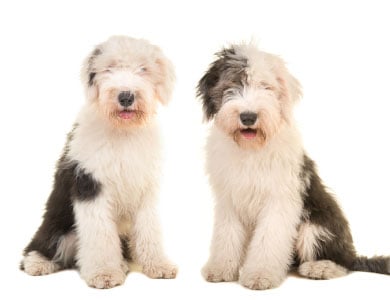
Life expectancy and health
These dogs have an average lifespan of 10 to 12 years. Regular exercise, such as daily walks, is recommended to help your dog live a long and healthy life.
Like all breeds, Old English sheepdogs are prone to some health problems more than others, including hip dysplasia, cataracts, glaucoma, entropion, progressive retinal atrophy, thyroid problems, deafness, diabetes, various allergies and skin problems. A conscientious breeder will take the time to test its sires to avoid breeding dogs that have or are carriers of various health problems. Since it is impossible to fully guarantee a puppy’s genetics, it is important to see your veterinarian for periodic checkups throughout the dog’s life to identify potential health issues. An annual eye exam is also recommended, since eye problems can develop over time. With regard to hip dysplasia, if no problems arise and none are discovered through X-rays by the time the dog is two years old, you can assume that your dog is free from joint problems, since the skeleton is fully developed by that age.
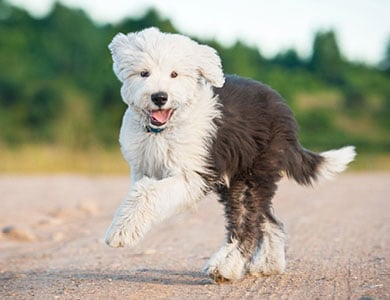
Energy level and temperament
The Old English sheepdog is often described as a calm, gentle breed with a clownish energy and a tendency to herd people or objects like it would for other animals. It is considered intelligent, sociable and easily adaptable. Given its gentle nature, the breed is well suited for families with children.
In terms of energy level, this herding breed needs a great deal of physical and psychological stimulation to develop and be happy. If the dog’s family does not live in a rural setting, the dog can adapt to life in the suburbs, as long as it is able to enjoy outdoor activities such as hikes in the woods and long walks with its owners. However, once indoors, old English sheepdogs are relatively calm and not particularly destructive.
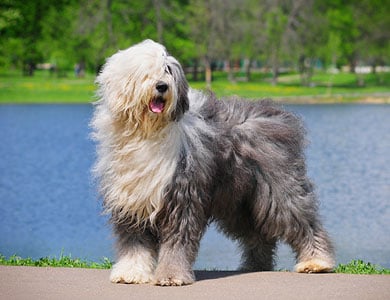
Maintenance and grooming
Old English sheepdogs tend to lose most of their undercoat during seasonal shedding. However, their guard hair sheds very little and can reach an impressive length if not trimmed. It is important to brush them regularly during shedding periods to remove dead hair before it gets all over your floor and sofa. The rest of the time, deep brushing two or three times a week should be enough to keep your dog’s coat healthy.
Most old English sheepdog owners prefer to shave their dogs to make their shaggy coats easier to maintain and avoid knots that could form near the skin. Although it is not recommended to shave some breeds, it is entirely acceptable to do so with old English sheepdogs. Their nails should be clipped regularly, and their floppy ears should be cleaned regularly to prevent infections from residual moisture.
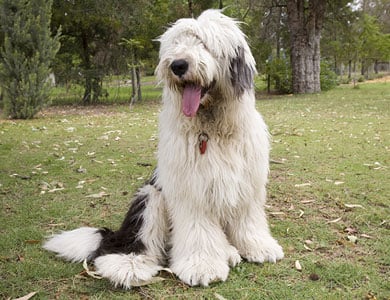
Origins
The origins of the old English sheepdog remain a question of great interest to breed enthusiasts, constantly giving rise to new theories and discoveries. However, some indications suggest that its origins date back to the early 19th century, more specifically in the counties of Devon and Somerset and the Duchy of Cornwall in southwest England. Some maintain that the bearded collie played a key role in developing the breed. Others claim that the south Russian sheepdog (Yuzhnorusskaya Ovcharka) is among the ancestors of the old English sheepdog; the similar appearances of these two breeds seems to confirm this theory.
Some writings of the time refer to “drovers” who were employed mainly to drive sheep and cattle to market. Apparently, the dogs of these drovers were exempt from taxes because they were working dogs. Proof of the dog’s occupation was a docked tail, which led to the breed’s “bobtail” nickname. The tradition of tail docking remains for several herding breeds, such as Welsh corgis. The breed was exhibited for the first time at a show in Birmingham, England, in 1873, and the breed was recognized in North America by the American Kennel Club in 1905, followed by the Canadian Kennel Club a few years later.
For more information, contact a registered breeder at the Canadian Kennel Club, who can answer all your questions. You can also contact the organization for information on breeders and the various breed clubs in Quebec and elsewhere in Canada.







